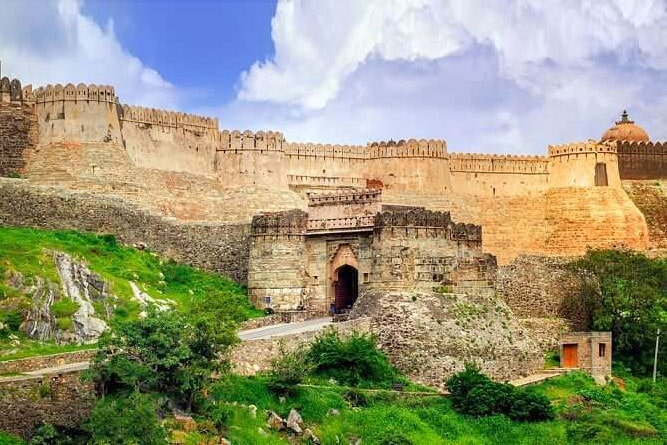Kumbhalgarh Fort
Fort, 81 km from Udaipur
could-see attraction
Opening hours: 9:00am-6:00pm
Address: Kumbhalgarh, Rajasthan
Ticket price: Indian/foreigner ₹40/600
Visit duration: People typically spend up to 1.5 hour here
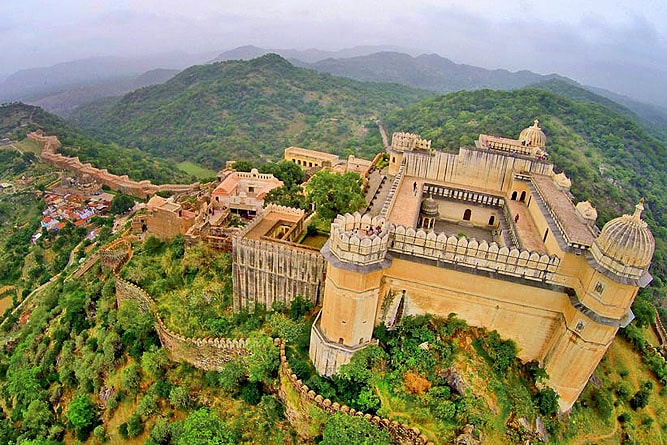
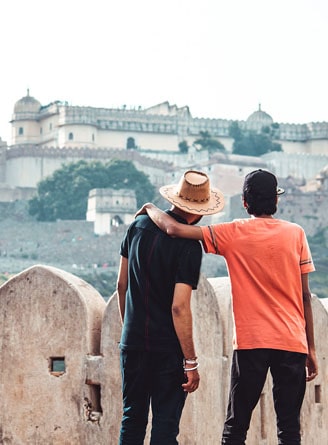
About Kumbhalgarh Fort
Kumbhalgarh Fort is a Mewar Fortress in Rajasthan lying on the western side of the Aravalli hills. The lofty walls of the fortress are the second longest in the world giving it the name Great Wall of India.
The countenance of the 500 years old enormous fortress appears to be the inception of the concept of impenetrable and humongous architecture. The fort has served as the safe house for the Mewar royals during times of war. The architecture of the fort features the invincible stronghold of Rajput supremacy.
In 2013, UNESCO announced the Kumbhalgarh Fort as a World Heritage Site.
History of Kumbhalgarh Fort
The Kumbhalgarh Fort is named after its creator, king Rana Kumbha. He was a ruler of the Sisodia Rajput clan, who built this fortress in the 15th century.
Before the arrival of Rana Kumbha, the fort was limited to a small hilly area ruled by King Samprati, a Jain prince from the Mauryan era.
The impenetrable feature of the fort rescued Prince Udai, the infant king of Mewar and the founder of Udaipur city who was smuggled to the fort from Chittoor in 1535.
The fort has been attacked by several invaders like Ahmed Shah I in 1457, Muhammad Khalji in the mid-15th century and Shahbaz Khan, a general of Emperor Akbar. Shahbaz Khan was successful in seizing the Fort.
At the beginning of the 19th century, the fort returned to the Mewar when Maharana Bhim Singh signed an alliance treaty with the British Empire. Since India’s Independence, the fort is now managed by the Archeological Survey of India.
The Kumbhalgarh Fort is the birthplace of the military hero, Maharana Pratap who resisted the Mughal expansion.
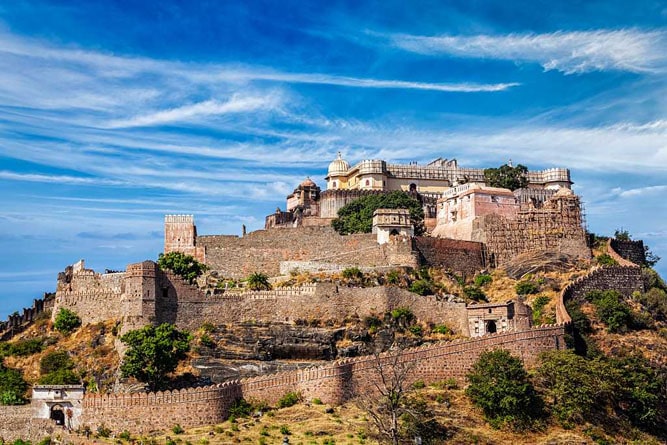
Architecture of Kumbhalgarh Fort
The Kumbhalgarh Fort is seated at a height of 3600 feet. It has three palaces which are Kumbha Palace, Jhalia ka Malia or Palace of Queen Jhalia and Badal Mahal.
The fort begins from two thick circular towers carved from grey stone and linked by a bridge. It forms an enormous giant arched-shaped gateway through which we reach the Ram Pol or the main entrance. The doors have iron spikes protruding from them.
The gateway is flanked on both sides by a thick defensive wall which is 36 kilometres in length and 15 metres in width. The formidable walls have tapered openings that acted as a shield for archers while aiming at the enemy.
The pinnacle of the fort is reached through a twisting path on the Aravalli Hills. This feature acted as an obstacle for the enemies during the invasion. The Kumbhalgarh Fort has several gates or Pols like Aaret Pol, Halla Pol, Hanuman Pol or Ram Pol, Bhairon Pol, Chaugan Pol, Nimboo Pol, Pagda Pol and Ganesh Pol.
Ganesh Temple was built by Maharana Kumbha and is dedicated to Lord Ganesha. It is considered one of the oldest temples in the complex. Ganesha Temple is settled to the left of the Ram Pol. The temple is elevated 12 feet and a flight of stairs leads you to the altar. To its right side on the hill, the slope is the Charbhuja temple. It is dedicated to the four-armed goddess. The temple has a raised platform and the eastern entrance is enclosed by a wall.
Rana Kumbha constructed the Vedi Temple, a Jain temple, settled near the Hanuman Pol. The temple has a three-storeyed octagonal edifice has a flight of stairs to reach the lifted altar. It has a dome-shaped canopy supported by thirty-six pillars. Vedi Temple was built to perform rituals after construction. Maharana Fateh Singh renovated the temple later. To the east of the Vedi Temple lies a triple shrine temple.
Neel Kanth Mahadeva temple, built in 1458, is dedicated to lord Shiva. It is situated on the eastern side of the fort. The altar houses an idol of Shiva carved from black stone and is depicted with 12 hands. The temple consists of a massive dome and 24 pillars with intricate carvings, a wide courtyard, and a 5-feet high lingam which is a figurine symbol of Lord Shiva. Maharana Kumbha started his day by praying at this temple. The inscriptions state that Rana Shanga renovated the temple. To its south lies the Mataji temple, also called the Kheda Devi temple.
Bawan Devi Temple has fifty-two shrines in one complex and it derives its name from the “bawan” which means fifty-two. The complex has only one entrance. An image of Jaina Tirthankara is engraved on the doorway. The two big shrines, located in the centre, are surrounded by the remaining smaller ones. The bigger shrine has a sanctum, an open mandapa and an antarala.
Parsva Natha temple, 1513, Bawan temples and Golera temple are the principal Jain temples in the Kumbhalgarh Fort. Mamdeo temple, Surya Mandir or Sun temple and Pital Shah Jain temple are the other temples inside the complex.
After a fairly easy trek, you reach the Bhairav Pol. This leads you to another gate called the Chaugan Pol. Beyond the gate, you can see ruins of arcade columns and walls and a closed building. Beside the restricted building is a rectangular building with numerous alcoves that are filled with wooden doors followed by an old house in ruins and it is settled beside the Kumbha Palace. A pillared corridor building housing several ballistae is settled near the palace.
The Kumbha Palace, a double-storeyed building, is located near the Pdga Pol. It is built in traditional Rajput style with attractively painted frieze with elephants, crocodiles and camels.
A quadrangle open veranda enclosed by an arcade column corridor or a stunning blue durbar hall of the two-storied building. With a circular Ganesh temple topped with a chattri and supported by pillars settled at a corner. The corridor separated the men's palace from the women's palace.
Rana Fateh Singh built the Badal Mahal at the pinnacle of the fortress.
Trekking to the top to arrive at the two storied building that has the same separate men's and women's palaces. The interior is painted in pastel colours and decorated with 19th-century wall paintings and appealing friezes. The latticework or stone jali screens facilitated the queens' participation in court events in privacy.
The loftiest point of the fort offers a panoramic view of the jungle, hillsides and the desert.
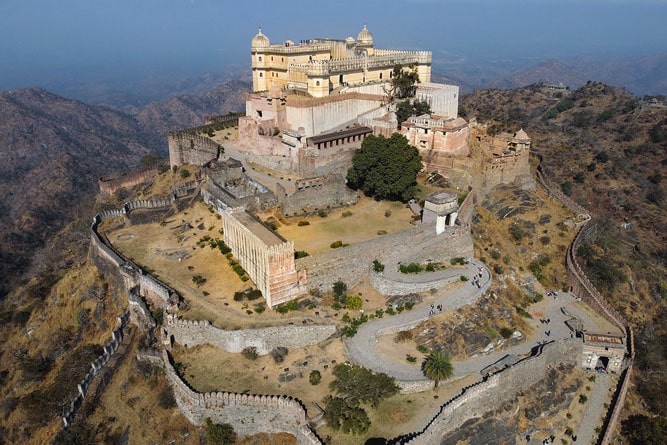
Entry fee and timings
The Kumbhalgarh Fort is open every day from 9:00 am to 6:00 pm. The entry fee for Indians is ₹40 and for foreigners, it is ₹600. For videography, you have to pay a nominal charge of ₹25.
Facts and tips about Kumbhalgarh Fort
- The fort houses 360 temples, many of which date back to the Mauryan period in the 2nd century BC. Out of these, 300 are Jain temples and the rest belong are Hindu temples. One of the temples is dedicated to Lord Brahma, Lord Vishnu and Lord Shiva. The fort also houses 700 cannon bunkers.
- The defence of the Kumbhalgarh Fort was so strong that it took an allied force of Amber, Marwar and the Mughals to breach the fortress. However, the Mughal king, Akbar, only managed to control the fort for only two days.
- The layout of the fort requires trekking. So it is better to wear comfy footwear and attires and carry umbrellas, caps and water bottles.
- There is a Light and Sound Show at 6:30 pm in Hindi at the fort. The ticket for the show is ₹118 for Indians and ₹236 for foreigners.
How to reach Kumbhalgarh Fort
Kumbhalgarh Fort is situated between Jodhpur (4-hour drive) and Udaipur (2-hour drive). The fort can also be reached from Ranakpur Jain Temple in 1 hour.
See location on Google Maps
Other attractions near Kumbhalgarh Fort
- Ranakpur - 33 km
- Udaipur - 81 km
- Mount Abu - 170 km
- Jodhpur - 180 km
- Pushkar - 228 km
- Jaipur - 350 km
FAQs about Kumbhalgarh Fort
1. Do you need to hire a guide during the tour of the Kumbhalgarh Fort?
Yes, it would provide a better tour experience if you hire a guide at the fort. Since there are numerous edifices in the complex, having a guide will help you understand and identify each edifice.
2. What are the things to do at the fort?
Besides enjoying the panoramic view of the complex from the highest point, you can watch a magnificent sunset and enjoy the golden beauty of the fort. Camel Safari might be available in the fort.
3. Was Maharana Pratap born in the Kumbhalgarh Fort?
Maharana Pratap was born in Jhalia ka Malia or the Palace of Queen Jhalia in the Kumbhalgarh Fort.
